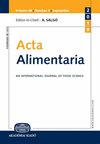Effects of gamma irradiation, osmotic and freezing processes on chemical, microbial, and pest characteristics of dried Iranian barberry fruit during storage
IF 1
4区 农林科学
Q4 FOOD SCIENCE & TECHNOLOGY
引用次数: 0
Abstract
Seedless barberry is a medicinal shrub and has been cultivated in Iran for more than two centuries. It is perishable with short shelf-life. Irradiation has shown to improve microbial safety and expands durability of raw fruits. Undoubtedly, current food processes undesirably affect bioactive compounds such as anthocyanins. Fresh barberry fruit was harvested in Birjand city by methods including “cutting branches” and “collecting fallen fruit under shrubs”, which locally are known as “puffy barberry” and “jewel barberry”, respectively. Some of the fresh barberries were treated by osmotic solution and then they have been dried. Untreated dried fruit was processed by freezing. Osmotic and frozen treatments were packed in polyamide film. Some of the dried jewel/puffy barberries packed in polyamide film were irradiated at doses of 0, 3, 5, and 10 kGy. All samples were stored at 4 and 25 °C for 6 months. Effects of barberry types (puffy/jewel), processes, storage time and temperature on chemical, microbial, and pest characteristics of dried barberry fruit were evaluated. Puffy barberry gamma irradiated with 5 kGy after 6 months of storage at 4 °C showed acceptable properties. Irradiation and storage at 4 °C were reported as optimal processing and storage conditions for barberry fruit.辐照、渗透和冷冻处理对干燥伊朗杨梅果实贮藏期间化学、微生物和害虫特性的影响
无籽barberry是一种药用灌木,在伊朗已经种植了两个多世纪。它易腐烂,保质期短。辐照已经证明可以提高微生物的安全性,并扩大生果的耐用性。毫无疑问,目前的食品加工过程不希望影响花青素等生物活性化合物。Birjand市通过“剪树枝”和“在灌木下收集倒下的果实”等方法收获了新鲜的barberry果实,当地分别称之为“蓬松barberry”和“珠宝Barbrry”。一些新鲜的蓝莓经过渗透溶液处理,然后进行干燥。未经处理的干果经冷冻处理。将渗透处理和冷冻处理填充在聚酰胺膜中。包装在聚酰胺膜中的一些干燥的宝石/蓬松的杠铃以0、3、5和10的剂量照射 kGy。所有样品分别储存在4和25 °C,持续6个月。评价了浆果类型(蓬松型/宝石型)、贮藏过程、贮藏时间和温度对干浆果化学、微生物和害虫特性的影响。用5 储存6个月后4 °C显示出可接受的性能。辐照和储存在4 据报道,°C是barberry果实的最佳加工和储存条件。
本文章由计算机程序翻译,如有差异,请以英文原文为准。
求助全文
约1分钟内获得全文
求助全文
来源期刊

Acta Alimentaria
农林科学-食品科技
CiteScore
1.80
自引率
0.00%
发文量
47
审稿时长
18-36 weeks
期刊介绍:
Acta Alimentaria publishes original papers and reviews on food science (physics, physical chemistry, chemistry, analysis, biology, microbiology, enzymology, engineering, instrumentation, automation and economics of foods, food production and food technology, food quality, post-harvest treatments, food safety and nutrition).
 求助内容:
求助内容: 应助结果提醒方式:
应助结果提醒方式:


